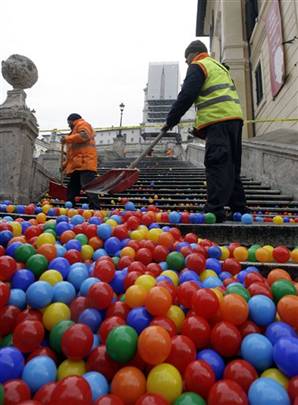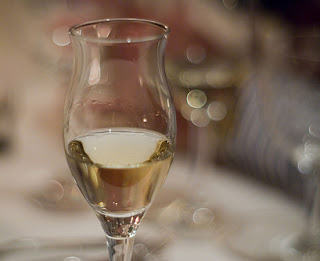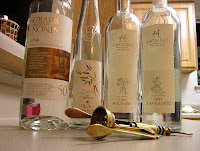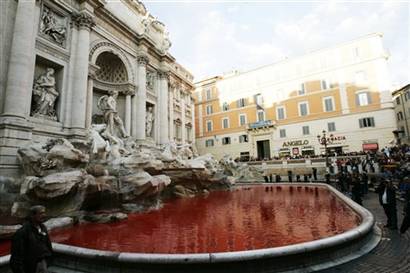Archive for the ‘uniquely italian’ Category
having a ball in rome
*Updated to direct you to what Juli, a trusty correspondent in Umbria, dug up about Graziano Cecchini and the ball stunt: Behind the Balls.
 The other day Rome’s Spanish Steps were having a ball.
The other day Rome’s Spanish Steps were having a ball.
Well, actually a half million of them as red, blue, yellow, and green balls flowed down one of the Eternal City’s most famous landmarks.
The rainbow spectacle was the doing of Graziano Cecchini who commented that we use “art — if we want to call it art — to stress our malaise.”
Cleaners were on the ball, so to speak, and got the lot of balls cleared out rather quickly, although they also had help from tourists who grabbed some of the only free souvenirs they’d find in the Bel Paese. Word has it that some balls even quickly found their way to eBay.
Some of you may remember Cecchini as the mastermind behind this last year:
This is the Trevi Fountain dyed red in October. Leaflets found nearby said that the red represented the red carpet of the Rome Film Festival and the water was dyed red in protest of the expenses incurred organizing the event.
After the Trevi Fountain incident, Cecchini was investigated for possibly damaging historical monuments, but experts said that, thankfully, none of the red color had seeped into the 18th century fountain’s marble structure.
So what do you think about such displays?
Art? Vandalism?
Inspiring? Disgusting?
Does it make you want to browse listings of Rome hotels, make a reservation, and wait for another show?
And would you have, ahem, grabbed a ball–or did you?
Do tell.
Buon weekend!
La Musica Calabrese – Calabrian Folk Music
 One of my favorite parts about living here is that you never know when you’ll be caught up in an impromptu concerto. Seriously.
One of my favorite parts about living here is that you never know when you’ll be caught up in an impromptu concerto. Seriously.
Now I’m sure some of you are thinking “Ah there goes another one of those stereotypes of ‘la dolce vita’ that simply doesn’t exist in real life Italy.”
Well I’m here to tell you that in small town Calabria, most males of all ages seem to play the guitar and will gladly break it out and start singing — especially the later into the evening it gets (and the more grappa that is flowing). And for those of you reading this who have visited here, chances are you can back me up on this.
In other words, we may miss out on a lot of “conveniences” down here, but at least we have la musica.
In fact the other night at New Year’s Eve dinner, one of the younger boys who is just learning to play the chitarra battente (pictured at left) asked for some advice from Mimmo, our host and lead singer/guitar player of Marasà, a local band that performs traditional Calabrese music with a bit of an updated twist.
I just love how generation after generation picks up these songs and instruments with pride, keeping the tradition going, not feeling embarrassed or shy in the least as they sing along (loudly) when the guitar shows up.
For anyone who thinks that Calabrese music and Calabrese in general is dying out, here’s a short clip of Mimmo encouraging yet another Calabrese boy on how to play the traditional way:
Although Italian musical heritage goes back centuries, including the famous chants of the Gregorian monks, Calabrian music has its own unique tradition and is rooted in songs about peasant life in the feudal system and all it entails–sung in Calabrese accompanied by Calabrian instruments.
It is music of the people, by the people, for the people, so to speak, and tells stories of both hope and hopelessness–common conflicting emotions for many Calabresi throughout the centuries.
Traditional Calabrian folk music has some common elements: high, strong vocals, a catchy, nearly hypnotic rhythm, and a bittersweet raw passion with any combination of tambourine, guitar, chitarra battente, accordion, zampogna (bagpipes), lira, mandolin, drums and more. The song rhythm you’ll hear often is the tarantella, a traditional southern Italian folk dance that was performed by female victims of spider bites to rid themselves of the venom.
There’s a great description of Calabrian music heritage here if you’re interested, but I think George Gissing sums it up pretty well in his 1901 travel memoir:
Listen to a Calabrian peasant singing as he follows his oxen along the furrow,
or as he shakes the branches of his olive tree.
That wailing voice amid the ancient silence,
that long lament solacing ill-rewarded toil,
comes from the heart of Italy herself,
and wakes the memory of mankind.
~ George Gissing
By the Ionian Sea: Notes of a Ramble in Southern Italy
For me, there’s just nothing like that distinct Calabrese cry accompanied by the chitarra battente to take me back to when my ancestors walked these same streets, living much simpler yet much harder lives, imagining what they could offer their families if only they could get to l’America.
Goodness I wish I could go back and tell them.
You can hear more of Marasà here by clicking on “il disco” and then choosing songs. My favorites are Aquila bella, Canto ad aria, and Facci di n’ammendula and if you like bagpipes, be sure to check out A Nuziata.
If you’d like to order a Marasà CD of your very own, you know where to find me.
Buon Anno!
Wishing everyone . . .
May 2008 be your best year yet!
And remember, don’t eat chicken today
or you’ll be scratching (for money) all year . . .
pork (to live high on the hog) and lentils (“coins” to bring you money)
are the way to go!
Italian Citizenship Jure Sanguinis: How I Became Legal in Italy
Are you interested in Italian citizenship jure sanguinis? Here’s my story plus resources to help you obtain dual Italian-American citizenship as well.
Read on...Grappa: Italy’s Beloved Firewater
 In Wednesday’s Sweet Apple Omelet recipe from Gina DePalma’s fabulous Dolce Italiano, a little thing called “grappa” was one of the ingredients — and one that I omitted.
In Wednesday’s Sweet Apple Omelet recipe from Gina DePalma’s fabulous Dolce Italiano, a little thing called “grappa” was one of the ingredients — and one that I omitted.
Probably because I singled it out, there ended up being quite a bit of discussion in the comments about this uniquely Italian creation — questions that can be summarized as “What is grappa?”, “Why would you use grappa in desserts?” and “Does Gina have a particular fondness for it as it appears in quite a few Dolce Italiano recipes?”
Since there is some mystery surrounding this peculiar clear bevanda, today we’re talking grappa, and our source will be none other than Gina DePalma, who was more than happy to answer questions about its use in her recipes.
But first — what is it?
We needn’t go further than Dolce Italiano for the answer. Have I mentioned that beyond a fabulous collection of recipes, Gina also offers an amazing amount of information on Italy, festivals and celebratory foods, the Italian language, and baking equipment and techniques?
You can also learn the history of gelato, why you should always toast nuts before using them, how to test your oven’s prowess, and how to substitute different egg sizes in recipes.
And so much more!
In a section called “Ten Italian Ingredients You Should Know,” Gina writes about “the building blocks of [her] dessert repertoire.” These are the essential items in her pantry at Babbo, she says, and grappa is on that list.
From Dolce Italiano:
An aquavite, or “water of life,” grappa is made by distilling grape skins and grape pomace, and this characteristic distinguishes it from other distillates made from wine or fruit….Grape pomace is essentially the leftovers of the winemaking process–the skins, pulp, and seeds. The pomace is heated in a still to produce an alcoholic mixture, which is distilled to remove the solids along with water, impurities, methyl alcohol, and any other volatile substances. The grappa is then carefully aged in a multistep process, which ends with a final reduction of alcohol and cold-filtering. Skilled, traditional grappa distillers produce a drink that is filled with nuance and flavor.
As every region produces wine, every region also produces grappa, but it is the northern versions that get the most accolades, particularly those from Friuli-Venezia Giulia and the Veneto.
Which brings us to the Sweet Apple Omelet. As Gina pointed out in her email to me, the recipe itself comes from Friuli, and so grappa was a perfectly logical and tasty addition to it.
 But in general, Gina notes, “lots of pastry recipes–not just Italian–use spirits and distillates. Rum, brandy, framboise, even whiskey. Booze is there more than people realize, especially in European-style pastry.”
But in general, Gina notes, “lots of pastry recipes–not just Italian–use spirits and distillates. Rum, brandy, framboise, even whiskey. Booze is there more than people realize, especially in European-style pastry.”
I can certainly attest to that last part as sometimes it’s difficult to find a dessert here that *doesn’t* have some kind of alcohol in it — it’s even in children’s snacks! Here in the south where I am, grappa isn’t usually the addition of choice but there is a lot of rum, brandy, anisette, and even vincotto. All tasty to be sure.
So why would you use grappa in a dessert recipe? From the book, Gina says that that “a truly fine grappa will accent and improve whatever flavor is highlighted on the plate.” She particularly likes using grappa in fresh fruit desserts and says that it is “heavenly when added to a crepe batter or lightly sweetened whipped cream.”And about her allegedly using excessive amounts of grappa in the recipes?
“I think I use a good variety in the book — rum, amaretto, and grappa, mostly. I think that Americans see grappa as an unusual ingredient, and the recipes that use it have gotten more than their fair share of attention. But first and foremost, I use grappa in the recipes where it fits, either regionally, or because I think the flavor works really well.”So there you have it.
Now you know a little more about the mystical grappa, why Gina uses it, and why you should too.
I do want to be clear that I didn’t use grappa in the Sweet Apple Omelet because I didn’t have any. I was sick over the weekend when I needed to shop for ingredients, and since I wasn’t going outside, this meant no grappa-shopping either.
Related to that, even if I could’ve gotten my hands on some grappa (surely one of my neighbors has a stash, although it might be peperoncino-flavored!), my recovering stomach was certainly not up for even the smell of it. Or at least I didn’t want to risk it.
Next time I make the Sweet Apple Omelet though, I will certainly give the grappa a try in there. I trust Gina.
And now my mom does too because she just received her Christmas gift from me in the mail yesterday — her very own copy of Dolce Italiano! The mailman actually delivered it *while* I was on the phone with her.
It’s just the most wonderful time of the year, isn’t it?
Here are the previous Dolce Italiano recipe posts:
Mosaic Biscotti & Sicilian Pistachio Cookies, Sara’s Ms Adventures in Italy
Chocolate Kisses & Cassata alla Siciliana, Ilva’s Lucullian Delights
Ricotta Pound Cake & Sweet Apple Omelet, here!
Chestnut Brownies & Chocolate & Tangerine Semifreddo, Shelley’s At Home in Rome
Chocolate Salami, Jenn’s The Leftover Queen
Best of luck and buon weekend!
















